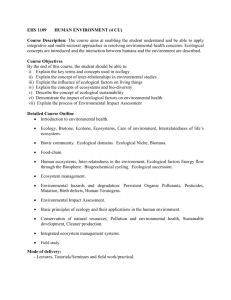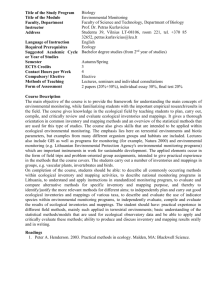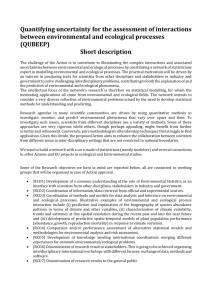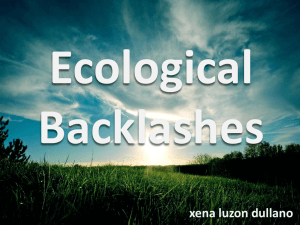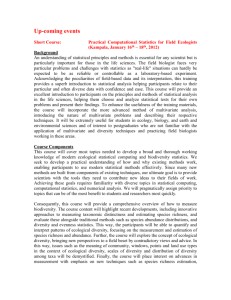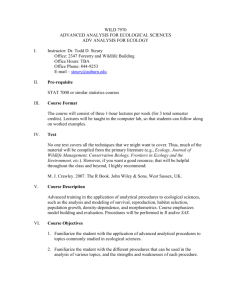Ecological Lens
advertisement
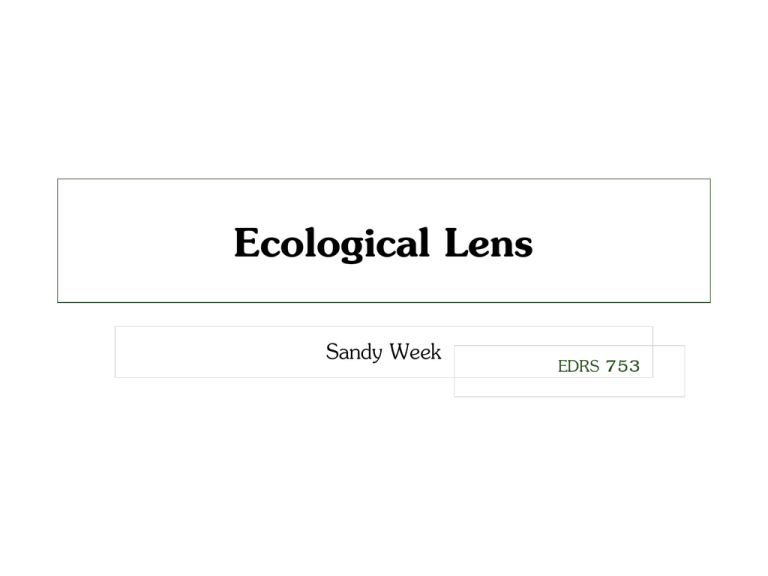
Ecological Lens Sandy Week EDRS 753 Ecology The branch of biology dealing with the relations and interactions between organisms and their environment, including other organisms… Examples… Predator vs. Prey – regulation of numbers in species Examples… Symbiosis - interaction between two different organisms usually to the advantage of each Examples… Competition for resources Diversity Person:Environment Walsh, W. B., (1936) Actual fit between an individual's or collective group's needs, aspirations, and capacities and the qualities and operations of their social and physical environments within particular cultural and historical contexts. • Level of fit • Adaptedness • Perceived level of fit Ecology of Human Development Urie Bronfenbrenner (1979) Ecological systems theory is an approach to study of human development that consists of the “scientific study of the progressive, mutual accommodation, throughout the life course, between an active, growing human being, and the changing properties of the immediate settings in which the developing person lives, as this process is affected by the relations between these settings, and by the larger contexts in which the settings are embedded” Example Article Ehrenreich, H., Reeves, P. M., Corley, S., & Orpinas, P. (2012) With Graduation in Sight: Perceptions of High- and Low-Aggression Students of the Journey to High School Completion • Used Bronfenbrenner’s ecological model & identified within each level of the ecological model (micro-, meso-, exo-, and macrosystems Campus Climate The transactional relationship of the social & physical environment Example Book Instead of linear thinking… Keiny, S. (2002) Ecological Thinking: A new approach to educational change (book) A community of learners which are autonomous and self-organizing Ecological Learning Theory Graham Davey (1989) Instead of operant conditioning… Uses a developmental or social cognitive view Example Article Brown, E. L., Kanny, M. A., Johnson B. (2014) “I Am Who I Am Because of Here!” School Settings as a Mechanism of Change in Establishing High-Risk Adolescents’ Academic Identities (article) • The study included “multiple perspectives of various school community members” • The school environment serves as a mechanism of change in supporting early adolescents’ academic identities Citations Banning, J. (Producer). (2013). Origins. The Campus Ecologist. Retrieved from www.campusecologist.com. Bronfenbrenner, U., 1917-2005. (1979). The ecology of human development: Experiments by nature and design. Cambridge, Mass: Harvard University Press. Brown, E. L., Kanny, M. A., Johnson B., “I am who I am because of here!”: School settings as a mechanism of change in establishing high-risk adolescents’ academic identities. (2014). The Journal of Early Adolescence, 34(2), 178-205. doi:10.1177/0272431613480271 Davey, G. (1989). Ecological learning theory. New York: Routledge. Ehrenreich, H., Reeves, P. M., Corley, S., & Orpinas, P. (2012). With graduation in sight: Perceptions of high- and low-aggression students of the journey to high school completion. School Psychology Quarterly, 27(4), 198-209. doi:10.1037/spq0000006 Evans, N. J., Forney, D. S., & Guido-DiBrito, F. (1998). Student development in college: Theory, research, and practice. San Francisco: Jossey-Bass Publishers. Ḳeni, S. (2002). Ecological thinking: A new approach to educational change. Lanham, Md: University Press of America. Margalef, R. (1968). Perspectives in ecological theory. Chicago: University of Chicago Press. Mizrahi, T., Davis, L. E., Oxford University Press, & National Association of Social Workers. (2008). Encyclopedia of social work. New York: Oxford University Press. Walsh, W. B., 1936, Craik, K. H., & Price, R. H. (2000). Person-environment psychology: New directions and perspectives. Mahwah, N.J: L. Erlbaum.




